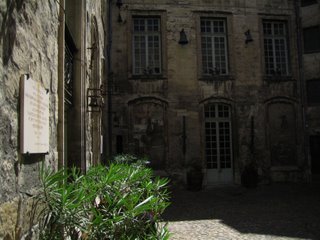 Dans la cour du Palais du Roure. Il fut commandé par le florentin Pierre Baroncelli en 1469, qui venait d'acquérir deux maisons et la taverne qui se trouvaient là et confia le chantier à un certain Antoine Collin qui a travaillé, entre autres, sur le magnifique "Petit Palais" de style Renaissance. Au début du XXe siècle, le poète et écrivain Fréderic Mistral, fervent médiateur de la culture provençale et conteur de sa mémoire, s'éprit de la superbe demeure et lui donna le nom de Palais du Roure ou Palais du Chêne. Jeanne de Flandreysy la racheta en 1918 et la sauva de l'oubli, y établissant "un foyer de culture méditerranéenne", repris plus tard par la ville.
Dans la cour du Palais du Roure. Il fut commandé par le florentin Pierre Baroncelli en 1469, qui venait d'acquérir deux maisons et la taverne qui se trouvaient là et confia le chantier à un certain Antoine Collin qui a travaillé, entre autres, sur le magnifique "Petit Palais" de style Renaissance. Au début du XXe siècle, le poète et écrivain Fréderic Mistral, fervent médiateur de la culture provençale et conteur de sa mémoire, s'éprit de la superbe demeure et lui donna le nom de Palais du Roure ou Palais du Chêne. Jeanne de Flandreysy la racheta en 1918 et la sauva de l'oubli, y établissant "un foyer de culture méditerranéenne", repris plus tard par la ville.Ce qui fait la magie de ce lieu, c'est sa situation, à la dérobée, soudainement visible dans l'interstice d'une petite rue. Si on passe trop vite, on ne le remarque pas, la rue est sombre et seule la lumière chaude présente dans la cour au-delà d'une porte entrebâillée et dont le cadre en pierre est magnifiquement sculpté, nous la fait connaître. Et alors, on ne peut être qu'émerveillé et ébloui, un bijou d'architecture qui nous fait revivre le XVe siècle. Un lieu, au détour d'un bout de rue, discret et pourtant si remarquable et beau. Fragment de la Renaissance toujours debout et riche de ses trésors cachés.
In the court of the Palais du Roure. It was ordered by the Florentin Pierre Baroncelli in 1469, who had just acquired two houses and the tavern where it is and entrusted the building site to a certain Antoine Collin who also worked on the splendid “Petit Palais” of Renaissance style. At the beginning of the XX th century, the poet and writer Frederic Mistral, enthusiastic mediator of the Provence culture and storyteller of his memory, got excited of the superb residence and give the name of Palais du Roure or Palate of the Oak. Jeanne de Flandreysy repurchased it in 1918 and lapse of memory saved it, establishing there “a hearth of Mediterranean culture”, taken again later by the city.
What makes the magic of this place, it's his situation, secretly, suddenly visible in the interstice of a small street. If you passes too quickly, you can't notice it, the street is dark and only the hot light present in the court beyond a "entrebâillée" door and whose framework out of stone is magnificiently carved, us makes known it. And then, you can only be filled with wonder and "éblouï", a jewel of architecture who can revives us the XVth century. A place, with the turning of an end of street, discrete and yet so remarkable and beautiful. Fragment of the Renaissance always upright and rich of his hidden treasures.
3 commentaires:
Just found your blog - what amazing photos and history!!! Just beautiful!!
I'm wondering if the mistral was named after Frederic Mistral?
Beautiful building about which the history adds more charm.
This waas great to read
Enregistrer un commentaire